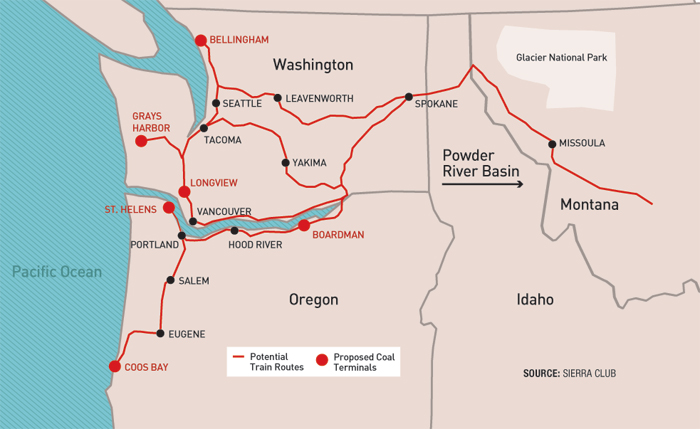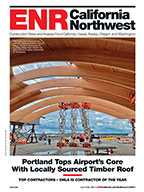Environmental resistance is mounting against six coal export terminals proposed for sites in Oregon and Washington. The terminals would receive shipments from the Powder River Basin in Montana and Wyoming that would go to Asian markets where coal-fired energy is in high demand.
State officials and the U.S. Environmental Protection Agency are asking the Army Corps of Engineers for a "cumulative" review of all the facilities' environmental and traffic-congestion impacts.
The opposition is raising concerns about potential risks associated with moving coal through the Northwest. At a May 7 rally in Portland, Robert F. Kennedy Jr., an environmental attorney and president of the Waterkeeper Alliance, warned that bringing coal into the region would "poison the groundwater and the air and … distort the entire economic system."
Proposals in Washington state include a 48-million-ton-per-year capacity terminal in Cherry Point, north of Bellingham, by Seattle-based SSA Marine; a 5-million- ton-per-year facility in Grays Harbor by Jacksonville, Fla.-based RailAmerica; and a $600-million terminal in Longview by locally based Millennium Bulk Terminals.
The latter project, planned to have full build-out capacity of 44 million tons per year, would create 2,700 jobs in the area during the five- to six-year construction phase, according to Millennium CEO Ken Miller. The company says it expects to have the terminal on line by 2015 and shipping coal no later than 2020.
In Oregon, Brisbane, Australia-based Ambre Energy is proposing a facility at the Port of Morrow on the Columbia River at which coal would be transferred to barges from rail. These barges would be towed to a coal-loading terminal at the Port Westward industrial park at the Port of St. Helens. The coal conveyance system would be capable of moving eight million tons a year.
Houston-based Kinder Morgan also proposed a separate 30-million-ton-per-year facility, valued at $150 million to $200 million, at the Port Westward site. But Portland General Electric has moved to halt that project. The utility, which operates two natural-gas facilities on the same property, controls site operations. The company says coal dust from the terminal could interfere with plant equipment. Kinder Morgan has not ruled out proposing an alternative.
There are plans for a third Oregon terminal in Coos Bay that could export six to 10 million tons annually, but details are still unclear, says Eric de Place, a senior researcher with the Seattle-based Sightline Institute, a public-policy research center.
If all the terminals were built, more than 100 million tons of Wyoming and Montana coal would be shipped annually to Asia through Northwest ports in coming years.
Currently, all projects are in the preliminary stages and have not received the necessary permits to move forward, says Lauren Goldberg, staff attorney for the environmental group Columbia Riverkeeper, Hood River, Ore. The proposals in Washington will require a state Environmental Policy Act review, the state equivalent of the National Environmental Policy Act, and environmental impact statements, she says.
Ambre Energy has applied for a state permit for the Oregon project. However, since Oregon lacks a state environmental policy act, it is uncertain whether each terminal proposal in the state will need an EIS.
Ambre also has applied to the Corps for a federal permit. As part of that permit's public-comment provisions, the Washington Dept. of Ecology has asked the Corps for a collective analysis of all terminal impacts in the two-state region, says Larry Altose, a department spokesman. EPA and Oregon Gov. John Kitzhaber (D) sent similar requests to the Corps last month, officials say.
Millennium officials have opposed the separate cumulative review, claiming the diverse locations of the terminals would make the analysis "unworkable and formidable," according to a locally published report.
"As the issues associated with the projects gain higher prominence, the level of resistance will undoubtedly grow," de Place says. "We are only now beginning to see the uptake of media coverage on the projects, which would be fundamentally transformative of the Northwest trade economy."



Post a comment to this article
Report Abusive Comment